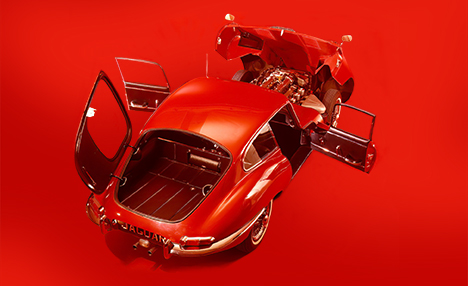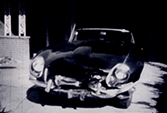Big, emotional, bear-hugging, steak-eating, STP pajama-wearing Andy Granatelli was the last guy you’d expect to see plotting over a breakfast table with the nutty Colin Chapman. Andy’s STP dollars had brought the two together, but on this October ’67 morning, only the brilliant Granatelli magnetism could have led Colin “I never eat breakfast; only black coffee” Chapman wrist-deep into rashers of bacon, a plate of greasy eggs, and a stock of muffins with marmalade. At the height of his fame in the mid-1960s, Andy Granatelli could convince anyone to do anything.
Granatelli’s own agenda was simple: Build a car that could win the Indy 500, or at least generate plenty of headlines by losing. To accomplish that, Andy Granatelli—the self-made, self-promoting, self-proclaimed American icon—would spend the 1960s hip-deep in Brits.
Before Chapman et. al. entered the Granatelli orbit, Andy had held the public’s attention through the power of the Novi V8. Bud Winfield laid out this supercharged, four-cam engine in 1938, and 23 years later it had gone down in history as a legendary, promise-filled failure. Novis had never won Indy; in fact, they hadn’t even qualified since 1958. So why had Andy Granatelli spent $10,000 for the Novi’s battered, dusty remains in 1961? In They Call Me Mister SOO, Andy’s 1969 autobiography, Granatelli gives equal credit to his own love of the legend and the guaranteed crowd appeal of resurrecting an obsolete jinx. What could bring Andy Granatelli—and therefore his STP merchandise—more media hubbub than that?
Andy spent the rest of the ’60s trying to answer that question. One promising avenue came when he met Stirling Moss, who’d recently won a rainy race at Oulton Park with an all wheel-drive showpiece called the Ferguson P99. All-wheel-drive, Moss told Andy, might be just the thing to tame the notoriously powerful Novi.
Andy paid the Harry Ferguson Research company $5,000 to bring the P99 to America. It arrived with stalwart Brit Jack Fairman in tow, and Granatelli was sold. Ferguson built essentially un unsized P99 for the Novi, which Bobby Unser drew for Indy ’64. The car was sidelined in a melee just moments after the start, but Andy stuck with Ferguson until USAC outlawed all-wheel-drive in 1969.
Granatelli’s second eye-opener came with Indy ’61 and a car that didn’t even make the field: the turbine-powered John Zink Trackburner. The car showed decent speed, but since engine supplier Boeing would only charge Zink if the Trackbumer made the show, he withdrew the entry instead. Boeing happily took the engine back gratis, viewing it none the worse for wear. A zero-maintenance powerplant that still retained its value after serious trials at Indy? That was something else worth noticing.
In the meantime, Granatelli had other plans—and now Colin Chapman was swirling into orbit. But back to turbines for a moment. Taken on balance, Indy was made for turbine power: braking, acceleration, and torque spread (three key turbine weaknesses) are relatively unimportant, while reliability, power, and weight (three turbo strengths) are critical. John Zink knew it; Jack Adams, whose turbine-powered Watson was banned as unsafe in 1966, knew it; and Andy Granatelli knew it.
By 1966, Granatelli was ready to go for it: turbine power, all-wheel-drive, the works. The car would also use a stainless-steel backbone frame that slung the driver on one side and a Pratt & Whitney ST6 turbine on the other, giving it a useful inside-corner weight bias. As it turned out, an outside contractor overcooked the ’66 car’s chassis during heat-treating, and Andy had to put the plan off until 1967. When it finally did arrive, STP Turbocar #40 was technically legal but just as Andy expected. It brought howls of protest from his rivals, most of whom had big money tied up in conventional cars. USAC slapped a seemingly impossible scatter shield rule on car 40, which Andy deftly sidestepped with an exotic titanium alloy. On the other hand, the Indy-ruling Hulman family loved the crowd-pleaser, and even gave it special dispensation to carry unprotected extra fuel tanks.
To make a very long story short and get along to Chapman, Parnelli Jones and Car 40 were 1967’s odds favorites. “It’s just flat-out the best damn car I’ve ever seen,” Jones said. He went on to dominate the race—only to have a six-dollar transmission bearing fail three laps from the end.
Granatelli was crushed. A.J. Foyt—one of the Turbocar’s most vicious detractors—inherited the win. And USAC suddenly became serious about hosing down the turbine, instituting rule after rule to Granatelli’s disadvantage. Andy took the group to court, but by protecting the competitiveness of its series, USAC was merely performing its main function. The suit was doomed to failure, and Andy must have known it; one assumes the publicity of the trial more than justified his legal fees.
By this time, Granatelli, who’d sponsored Lotus at Indy since 1966, was frequently turning to Colin Chapman for suspension and chassis advice. Now that Car 40 was being drummed out of contention, Andy asked Chapman to build him a new machine—one that might fit USAC’s new restrictions, but still be advanced enough to capture the public’s attention and maybe win the race. This was the topic of the breakfast meeting that started off this story.
By the lime Chapman began work, USAC hud reduced the key inlet-annulus size on turbines from 154cc to 102.5cc. Granatelli cried foul, claiming that other major rule changes usually followed a three-year grace period. Maybe so; nevertheless, Andy had barely said “boo” when USAC laid down the original 154cc limit a year earlier, arbitrarily making Jack Adams’ GE-powered Watson into a very costly paperweight. Andy’s SI6 measured 135cc.
Besides the 102.5cc annulus, Chapman’s other design restrictions were 9-inch rear wheels for the all-wheel-drive chassis (two-wheel drives got to use 14s) and the elimination of Car 40’s active airbrake. Plus, since Granaielll still hadn’t found a 102.5cc turbine when construction began, Chapman and designer Maurice Phillippe had to make the new Lotus Type 56 flexible enough for either turbine or Cosworth power. Complicating things even more, the thrifty Chapman pictured the 56 doing double duty: he’d let Andy fund its development for Indy, but use the same design for his own GP efforts. Thus, side saddle construction was out.
In January, United Aircraft of Canada informed Granatelli that its new, smaller Series 70 turbine would comply with the 1968 annulus limits after removal of the first two compressor gauges. This lowered bhp output to roughly 450, but Chapman’s new GP-slyle design was already much lighter than Car 40. 450 was enough. The Type 56 had a new wedge-shaped, downforce-inducing body (which Chapman later adapted to the world-beating Type 72); extra-tall Firestone rubber for the narrow Indy-spec rims; and the front/rear torque split was changed from 50/50 to 45/55 in an effort to reduce understeer. Most critically, Granatelli wanted to drop Car 40’s kerosene fuel in favor of unleaded gasoline to decrease throttle lag and increase mileage.
Popular newcomer Mike Spence was killed testing one of the Lotus 56s at Indy, and Chapman, still smarting from Jimmy Clark’s recent death, told team manager Andrew Ferguson to roll up the tents and sell off Team Lotus. Ferguson, knowing better, did nothing of the sort, and when Colin returned, nothing was ever said of the incident again.
For Granatelli, Indy ’68 was a replay of ’67. The race started with Joe Leonard on the pole, Graham Hill next to him, and Art Pollard on Row 4, all in STP-Lotus 56 Turbocars. Last year’s Car 40—substantially lightened (at great cost) and fit with a smaller engine—had been written off by Leonard in practice, and would never race again.
In the 500, Hill’s suspension failed on Lap 111. The remaining two Turbocars didn’t dominate as Car 40 had, but Leonard’s was strong enough to find him far in the lead when, after the 180th lap, the yellow light came on and the field bunched up. As the green signaled the start of racing again on Lap 192, Leonard and Pollard both floored their throttles and…nothing. The two remaining Lotuses coasted to a stop with identical fuel pump-drive failures. Neither Granatelli nor Pratt & Whitney had remembered that replacing the oily kerosene fuel with unleaded gas meant the shafts would be slightly under-lubricated.
For 1969 USAC cut the inlet-annulus size so far that turbines were effectively banned. That was the end of the turbine Indy car, but not quite the end of the turbine Lotus. Four Type 56s had been built; the third, Spence’s, was returned to England and slowly converted into the 56B Grand Prix car. Little more than minor bodywork, aero, and engine mods were needed, but Lotus’ all-wheel-drive Type 63 and rear-drive Type 72 were deemed more important, so progress was slow. The Formula One 56B didn’t debut until the 1971 season.
Perhaps not surprisingly, the now-aging Turbocar never look to F1 the way it had to Indy. The combination of throttle lag, brake heat, high fuel loads, and heavy Ferguson AWD all worked against it, and the 56B’s most notable finishes were an eighth in the Italian GP and second in a minor non-points race at Hockenheim. With the more traditional Type 72 now showing its true mettle, the 56B program was abandoned. Even so, the FIA would go on to outlaw all-wheel drive and turbines.
Both Chapman and Granatelli had good years ahead. Andy got his longed-for 500 win in 1969; the Cosworth-powered Type 72 would earn Lotus the Manufacturer’s Championship in 1970, ’72, and ’73. Neither Chapman, Ferguson, nor Granatelli would ever work closely together again, but their joint efforts in the turbine era still stand us one of the most interesting experiments in Indy history—and one of the most unlikely joining of forces seen in recent times.







'Round and Round with Andy Granatelli' has no comments
Be the first to comment this post!